Traditional Performance Management Systems: Why Organizations Should Follow Suit
VerifiedAdded on 2023/04/20
|11
|3416
|257
AI Summary
This essay discusses the limitations of traditional performance management systems, such as the Bell Curve Methodology, and explores the benefits of adopting an agile performance management approach. It highlights the need for continuous feedback, coaching, and communication in performance evaluation and goal setting. The essay also addresses the challenges and criticisms associated with traditional systems and emphasizes the importance of fairness and objectivity in performance appraisal.
Contribute Materials
Your contribution can guide someone’s learning journey. Share your
documents today.
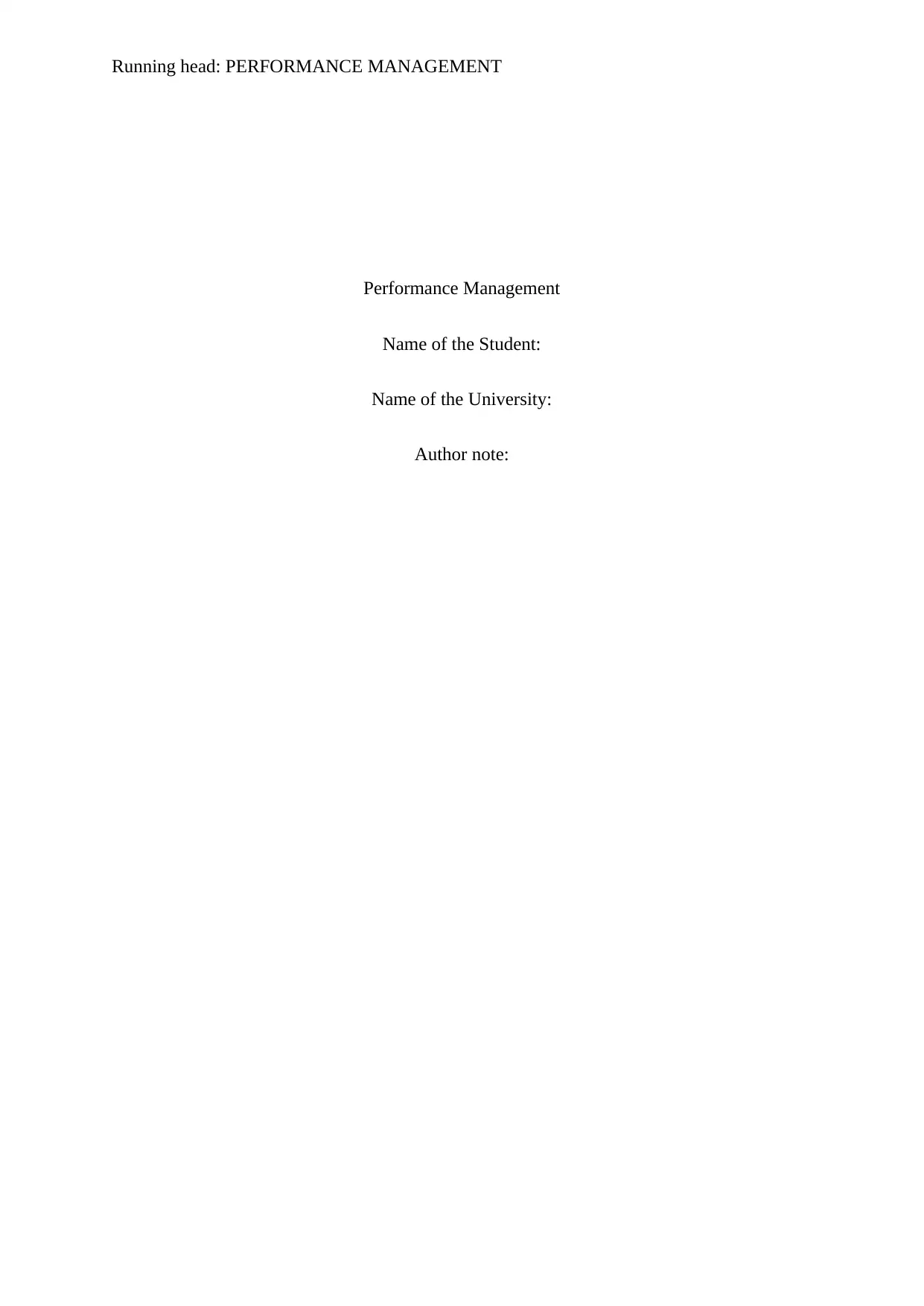
Running head: PERFORMANCE MANAGEMENT
Performance Management
Name of the Student:
Name of the University:
Author note:
Performance Management
Name of the Student:
Name of the University:
Author note:
Secure Best Marks with AI Grader
Need help grading? Try our AI Grader for instant feedback on your assignments.
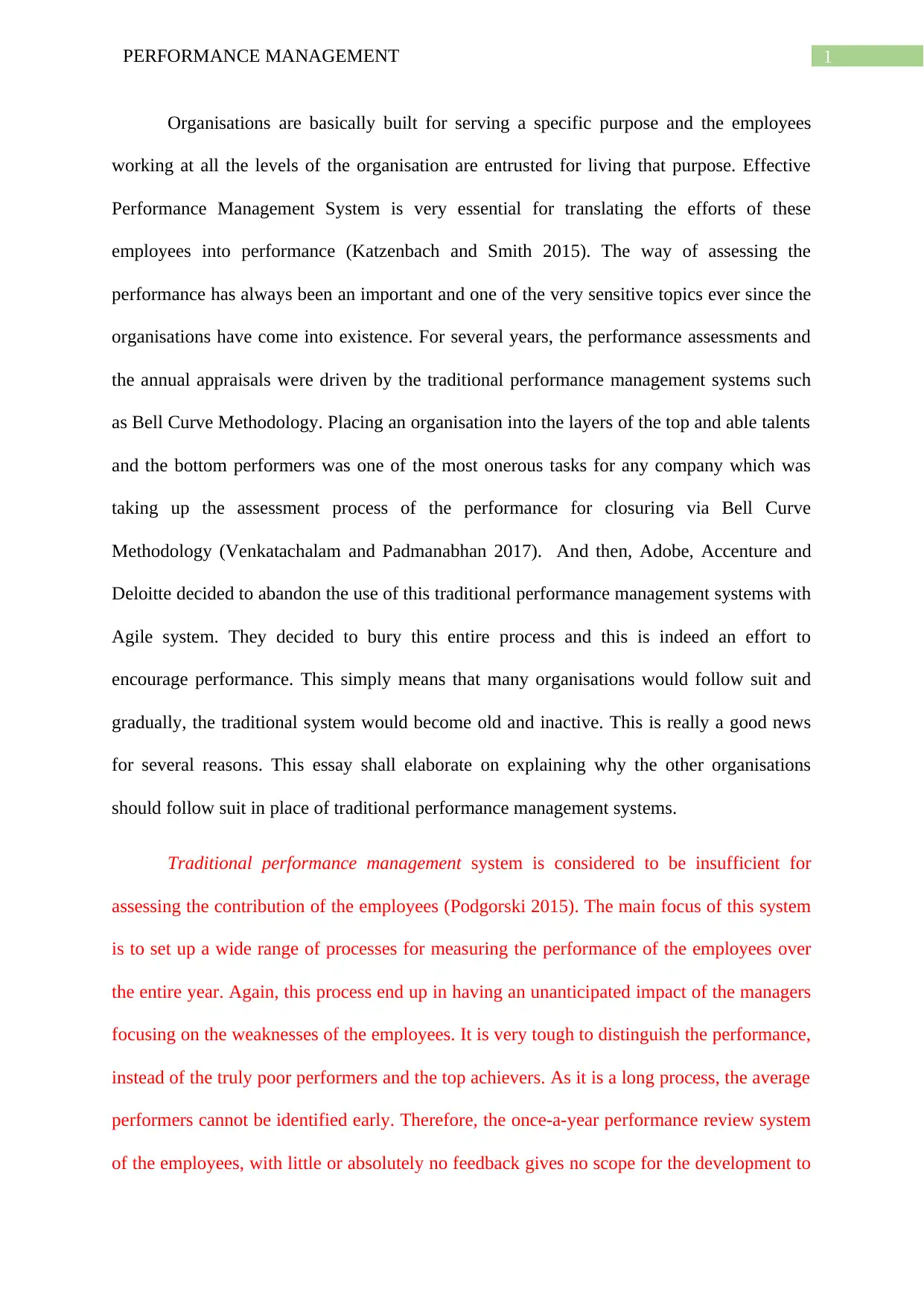
1PERFORMANCE MANAGEMENT
Organisations are basically built for serving a specific purpose and the employees
working at all the levels of the organisation are entrusted for living that purpose. Effective
Performance Management System is very essential for translating the efforts of these
employees into performance (Katzenbach and Smith 2015). The way of assessing the
performance has always been an important and one of the very sensitive topics ever since the
organisations have come into existence. For several years, the performance assessments and
the annual appraisals were driven by the traditional performance management systems such
as Bell Curve Methodology. Placing an organisation into the layers of the top and able talents
and the bottom performers was one of the most onerous tasks for any company which was
taking up the assessment process of the performance for closuring via Bell Curve
Methodology (Venkatachalam and Padmanabhan 2017). And then, Adobe, Accenture and
Deloitte decided to abandon the use of this traditional performance management systems with
Agile system. They decided to bury this entire process and this is indeed an effort to
encourage performance. This simply means that many organisations would follow suit and
gradually, the traditional system would become old and inactive. This is really a good news
for several reasons. This essay shall elaborate on explaining why the other organisations
should follow suit in place of traditional performance management systems.
Traditional performance management system is considered to be insufficient for
assessing the contribution of the employees (Podgorski 2015). The main focus of this system
is to set up a wide range of processes for measuring the performance of the employees over
the entire year. Again, this process end up in having an unanticipated impact of the managers
focusing on the weaknesses of the employees. It is very tough to distinguish the performance,
instead of the truly poor performers and the top achievers. As it is a long process, the average
performers cannot be identified early. Therefore, the once-a-year performance review system
of the employees, with little or absolutely no feedback gives no scope for the development to
Organisations are basically built for serving a specific purpose and the employees
working at all the levels of the organisation are entrusted for living that purpose. Effective
Performance Management System is very essential for translating the efforts of these
employees into performance (Katzenbach and Smith 2015). The way of assessing the
performance has always been an important and one of the very sensitive topics ever since the
organisations have come into existence. For several years, the performance assessments and
the annual appraisals were driven by the traditional performance management systems such
as Bell Curve Methodology. Placing an organisation into the layers of the top and able talents
and the bottom performers was one of the most onerous tasks for any company which was
taking up the assessment process of the performance for closuring via Bell Curve
Methodology (Venkatachalam and Padmanabhan 2017). And then, Adobe, Accenture and
Deloitte decided to abandon the use of this traditional performance management systems with
Agile system. They decided to bury this entire process and this is indeed an effort to
encourage performance. This simply means that many organisations would follow suit and
gradually, the traditional system would become old and inactive. This is really a good news
for several reasons. This essay shall elaborate on explaining why the other organisations
should follow suit in place of traditional performance management systems.
Traditional performance management system is considered to be insufficient for
assessing the contribution of the employees (Podgorski 2015). The main focus of this system
is to set up a wide range of processes for measuring the performance of the employees over
the entire year. Again, this process end up in having an unanticipated impact of the managers
focusing on the weaknesses of the employees. It is very tough to distinguish the performance,
instead of the truly poor performers and the top achievers. As it is a long process, the average
performers cannot be identified early. Therefore, the once-a-year performance review system
of the employees, with little or absolutely no feedback gives no scope for the development to
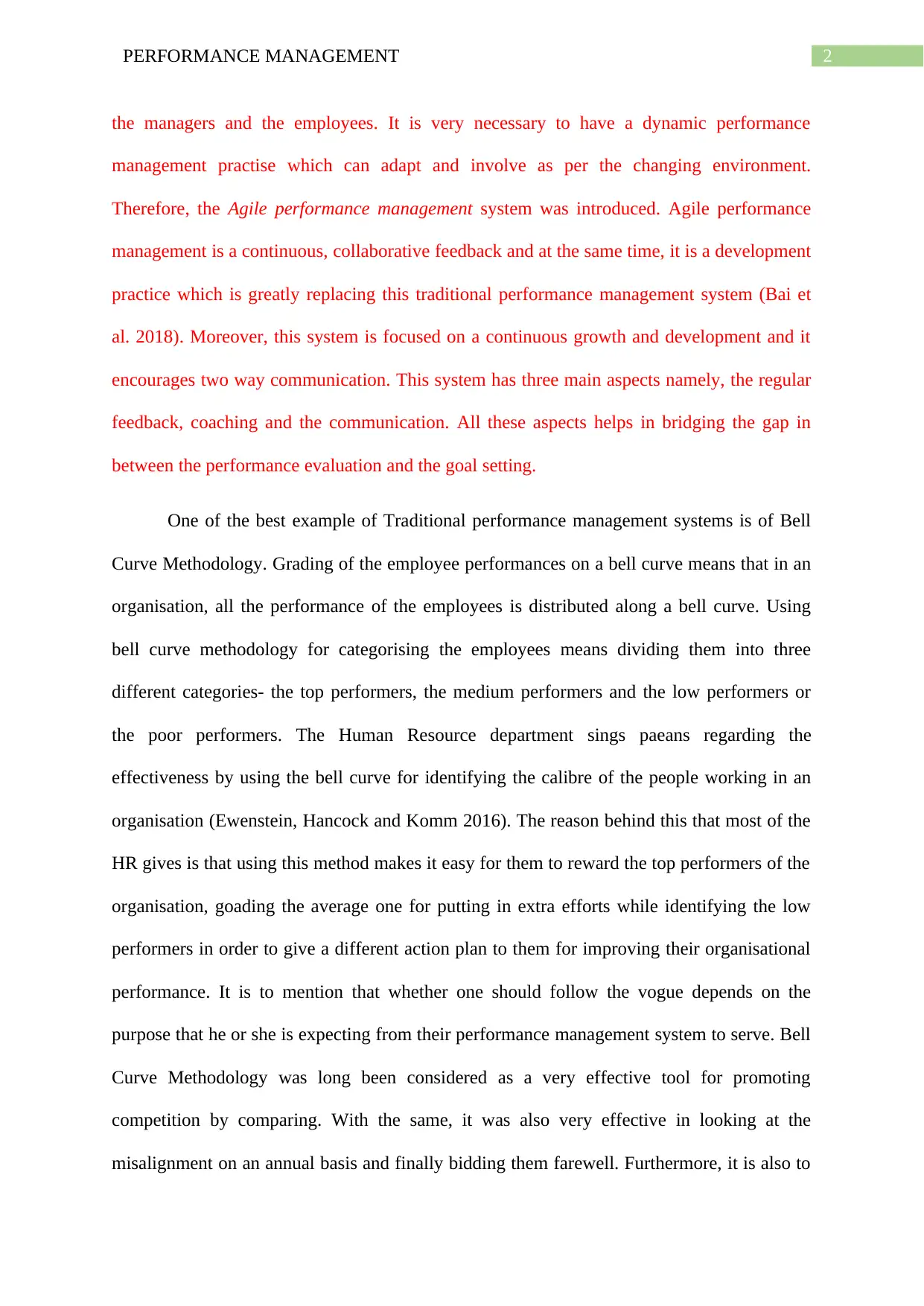
2PERFORMANCE MANAGEMENT
the managers and the employees. It is very necessary to have a dynamic performance
management practise which can adapt and involve as per the changing environment.
Therefore, the Agile performance management system was introduced. Agile performance
management is a continuous, collaborative feedback and at the same time, it is a development
practice which is greatly replacing this traditional performance management system (Bai et
al. 2018). Moreover, this system is focused on a continuous growth and development and it
encourages two way communication. This system has three main aspects namely, the regular
feedback, coaching and the communication. All these aspects helps in bridging the gap in
between the performance evaluation and the goal setting.
One of the best example of Traditional performance management systems is of Bell
Curve Methodology. Grading of the employee performances on a bell curve means that in an
organisation, all the performance of the employees is distributed along a bell curve. Using
bell curve methodology for categorising the employees means dividing them into three
different categories- the top performers, the medium performers and the low performers or
the poor performers. The Human Resource department sings paeans regarding the
effectiveness by using the bell curve for identifying the calibre of the people working in an
organisation (Ewenstein, Hancock and Komm 2016). The reason behind this that most of the
HR gives is that using this method makes it easy for them to reward the top performers of the
organisation, goading the average one for putting in extra efforts while identifying the low
performers in order to give a different action plan to them for improving their organisational
performance. It is to mention that whether one should follow the vogue depends on the
purpose that he or she is expecting from their performance management system to serve. Bell
Curve Methodology was long been considered as a very effective tool for promoting
competition by comparing. With the same, it was also very effective in looking at the
misalignment on an annual basis and finally bidding them farewell. Furthermore, it is also to
the managers and the employees. It is very necessary to have a dynamic performance
management practise which can adapt and involve as per the changing environment.
Therefore, the Agile performance management system was introduced. Agile performance
management is a continuous, collaborative feedback and at the same time, it is a development
practice which is greatly replacing this traditional performance management system (Bai et
al. 2018). Moreover, this system is focused on a continuous growth and development and it
encourages two way communication. This system has three main aspects namely, the regular
feedback, coaching and the communication. All these aspects helps in bridging the gap in
between the performance evaluation and the goal setting.
One of the best example of Traditional performance management systems is of Bell
Curve Methodology. Grading of the employee performances on a bell curve means that in an
organisation, all the performance of the employees is distributed along a bell curve. Using
bell curve methodology for categorising the employees means dividing them into three
different categories- the top performers, the medium performers and the low performers or
the poor performers. The Human Resource department sings paeans regarding the
effectiveness by using the bell curve for identifying the calibre of the people working in an
organisation (Ewenstein, Hancock and Komm 2016). The reason behind this that most of the
HR gives is that using this method makes it easy for them to reward the top performers of the
organisation, goading the average one for putting in extra efforts while identifying the low
performers in order to give a different action plan to them for improving their organisational
performance. It is to mention that whether one should follow the vogue depends on the
purpose that he or she is expecting from their performance management system to serve. Bell
Curve Methodology was long been considered as a very effective tool for promoting
competition by comparing. With the same, it was also very effective in looking at the
misalignment on an annual basis and finally bidding them farewell. Furthermore, it is also to
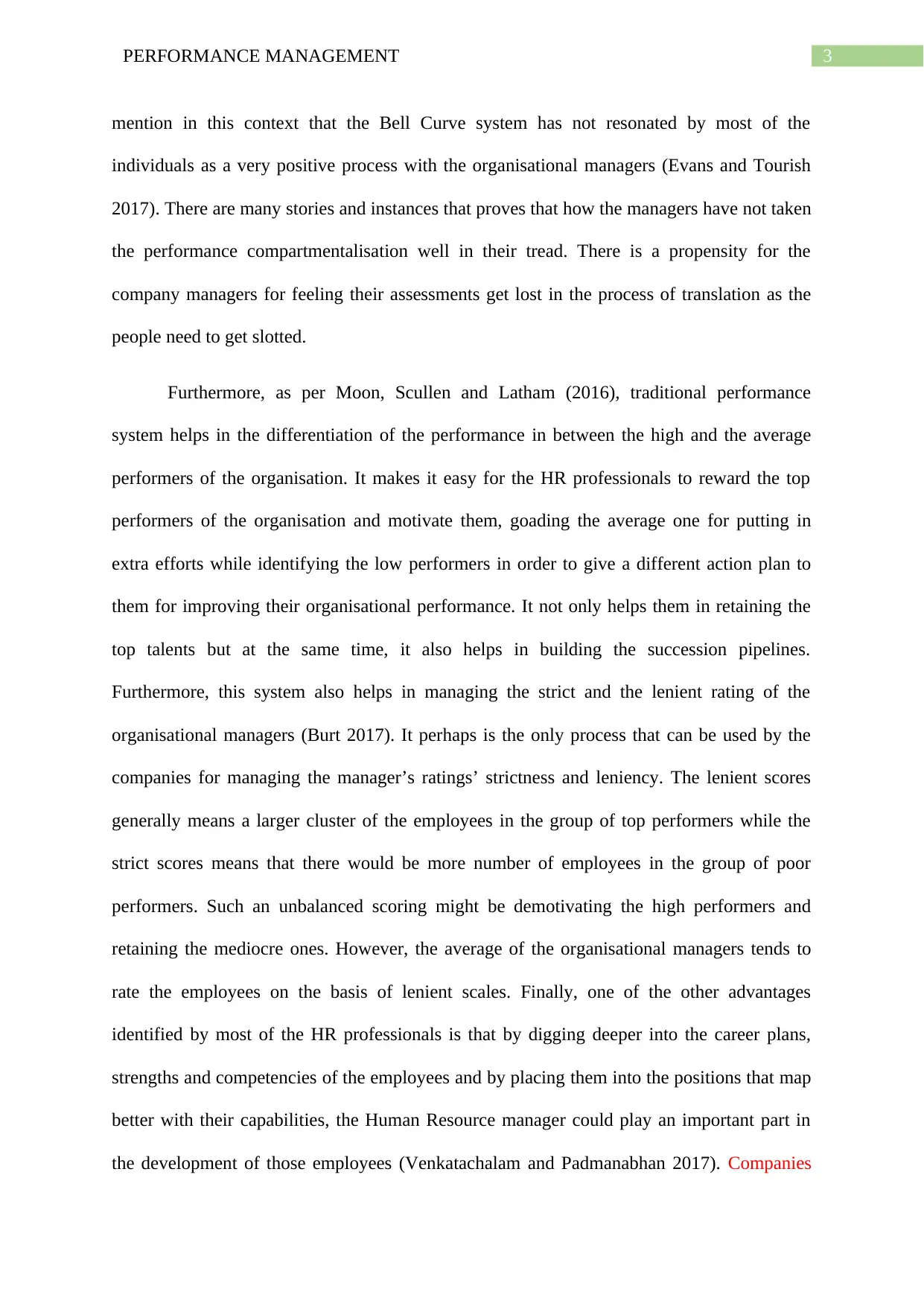
3PERFORMANCE MANAGEMENT
mention in this context that the Bell Curve system has not resonated by most of the
individuals as a very positive process with the organisational managers (Evans and Tourish
2017). There are many stories and instances that proves that how the managers have not taken
the performance compartmentalisation well in their tread. There is a propensity for the
company managers for feeling their assessments get lost in the process of translation as the
people need to get slotted.
Furthermore, as per Moon, Scullen and Latham (2016), traditional performance
system helps in the differentiation of the performance in between the high and the average
performers of the organisation. It makes it easy for the HR professionals to reward the top
performers of the organisation and motivate them, goading the average one for putting in
extra efforts while identifying the low performers in order to give a different action plan to
them for improving their organisational performance. It not only helps them in retaining the
top talents but at the same time, it also helps in building the succession pipelines.
Furthermore, this system also helps in managing the strict and the lenient rating of the
organisational managers (Burt 2017). It perhaps is the only process that can be used by the
companies for managing the manager’s ratings’ strictness and leniency. The lenient scores
generally means a larger cluster of the employees in the group of top performers while the
strict scores means that there would be more number of employees in the group of poor
performers. Such an unbalanced scoring might be demotivating the high performers and
retaining the mediocre ones. However, the average of the organisational managers tends to
rate the employees on the basis of lenient scales. Finally, one of the other advantages
identified by most of the HR professionals is that by digging deeper into the career plans,
strengths and competencies of the employees and by placing them into the positions that map
better with their capabilities, the Human Resource manager could play an important part in
the development of those employees (Venkatachalam and Padmanabhan 2017). Companies
mention in this context that the Bell Curve system has not resonated by most of the
individuals as a very positive process with the organisational managers (Evans and Tourish
2017). There are many stories and instances that proves that how the managers have not taken
the performance compartmentalisation well in their tread. There is a propensity for the
company managers for feeling their assessments get lost in the process of translation as the
people need to get slotted.
Furthermore, as per Moon, Scullen and Latham (2016), traditional performance
system helps in the differentiation of the performance in between the high and the average
performers of the organisation. It makes it easy for the HR professionals to reward the top
performers of the organisation and motivate them, goading the average one for putting in
extra efforts while identifying the low performers in order to give a different action plan to
them for improving their organisational performance. It not only helps them in retaining the
top talents but at the same time, it also helps in building the succession pipelines.
Furthermore, this system also helps in managing the strict and the lenient rating of the
organisational managers (Burt 2017). It perhaps is the only process that can be used by the
companies for managing the manager’s ratings’ strictness and leniency. The lenient scores
generally means a larger cluster of the employees in the group of top performers while the
strict scores means that there would be more number of employees in the group of poor
performers. Such an unbalanced scoring might be demotivating the high performers and
retaining the mediocre ones. However, the average of the organisational managers tends to
rate the employees on the basis of lenient scales. Finally, one of the other advantages
identified by most of the HR professionals is that by digging deeper into the career plans,
strengths and competencies of the employees and by placing them into the positions that map
better with their capabilities, the Human Resource manager could play an important part in
the development of those employees (Venkatachalam and Padmanabhan 2017). Companies
Secure Best Marks with AI Grader
Need help grading? Try our AI Grader for instant feedback on your assignments.
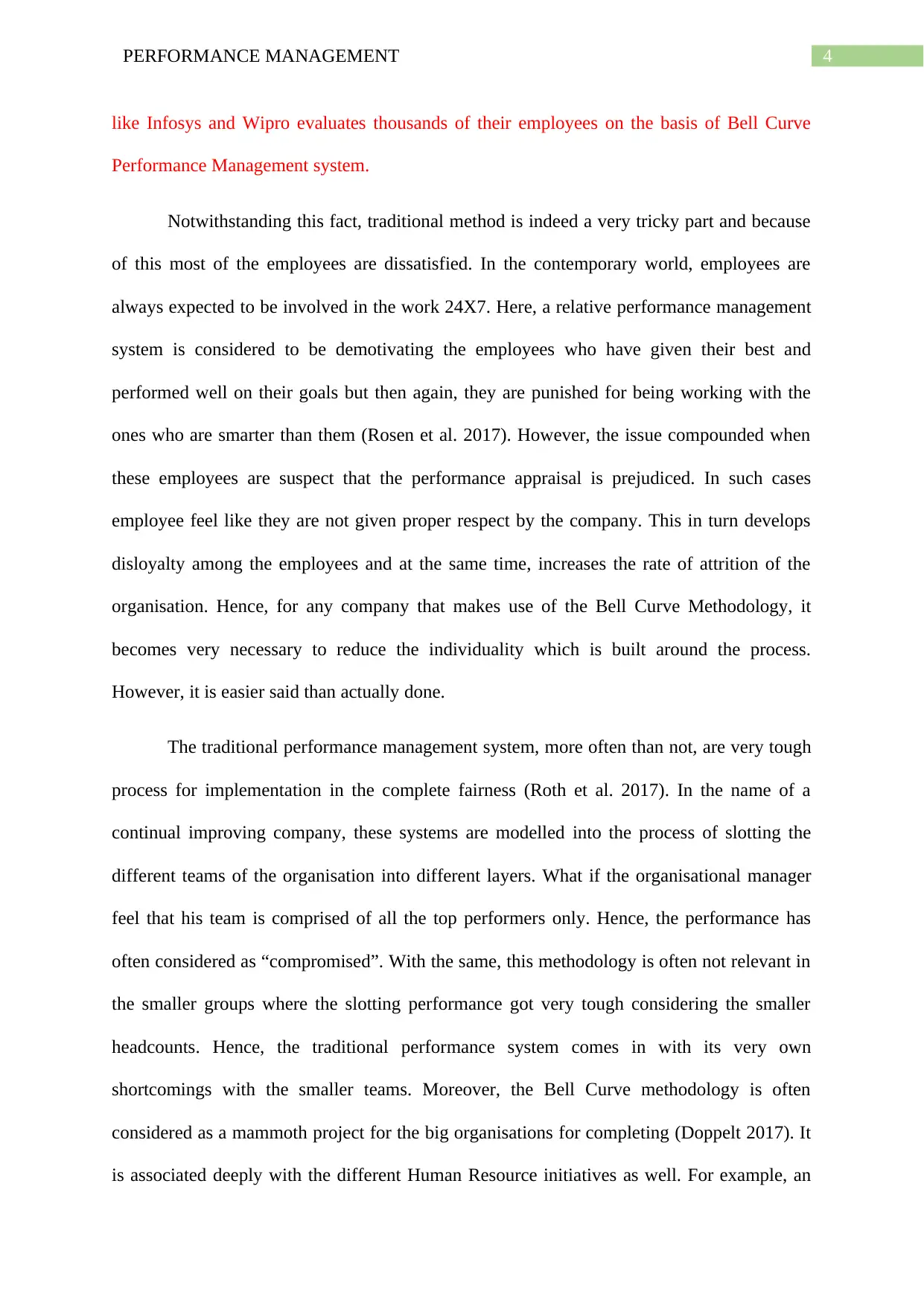
4PERFORMANCE MANAGEMENT
like Infosys and Wipro evaluates thousands of their employees on the basis of Bell Curve
Performance Management system.
Notwithstanding this fact, traditional method is indeed a very tricky part and because
of this most of the employees are dissatisfied. In the contemporary world, employees are
always expected to be involved in the work 24X7. Here, a relative performance management
system is considered to be demotivating the employees who have given their best and
performed well on their goals but then again, they are punished for being working with the
ones who are smarter than them (Rosen et al. 2017). However, the issue compounded when
these employees are suspect that the performance appraisal is prejudiced. In such cases
employee feel like they are not given proper respect by the company. This in turn develops
disloyalty among the employees and at the same time, increases the rate of attrition of the
organisation. Hence, for any company that makes use of the Bell Curve Methodology, it
becomes very necessary to reduce the individuality which is built around the process.
However, it is easier said than actually done.
The traditional performance management system, more often than not, are very tough
process for implementation in the complete fairness (Roth et al. 2017). In the name of a
continual improving company, these systems are modelled into the process of slotting the
different teams of the organisation into different layers. What if the organisational manager
feel that his team is comprised of all the top performers only. Hence, the performance has
often considered as “compromised”. With the same, this methodology is often not relevant in
the smaller groups where the slotting performance got very tough considering the smaller
headcounts. Hence, the traditional performance system comes in with its very own
shortcomings with the smaller teams. Moreover, the Bell Curve methodology is often
considered as a mammoth project for the big organisations for completing (Doppelt 2017). It
is associated deeply with the different Human Resource initiatives as well. For example, an
like Infosys and Wipro evaluates thousands of their employees on the basis of Bell Curve
Performance Management system.
Notwithstanding this fact, traditional method is indeed a very tricky part and because
of this most of the employees are dissatisfied. In the contemporary world, employees are
always expected to be involved in the work 24X7. Here, a relative performance management
system is considered to be demotivating the employees who have given their best and
performed well on their goals but then again, they are punished for being working with the
ones who are smarter than them (Rosen et al. 2017). However, the issue compounded when
these employees are suspect that the performance appraisal is prejudiced. In such cases
employee feel like they are not given proper respect by the company. This in turn develops
disloyalty among the employees and at the same time, increases the rate of attrition of the
organisation. Hence, for any company that makes use of the Bell Curve Methodology, it
becomes very necessary to reduce the individuality which is built around the process.
However, it is easier said than actually done.
The traditional performance management system, more often than not, are very tough
process for implementation in the complete fairness (Roth et al. 2017). In the name of a
continual improving company, these systems are modelled into the process of slotting the
different teams of the organisation into different layers. What if the organisational manager
feel that his team is comprised of all the top performers only. Hence, the performance has
often considered as “compromised”. With the same, this methodology is often not relevant in
the smaller groups where the slotting performance got very tough considering the smaller
headcounts. Hence, the traditional performance system comes in with its very own
shortcomings with the smaller teams. Moreover, the Bell Curve methodology is often
considered as a mammoth project for the big organisations for completing (Doppelt 2017). It
is associated deeply with the different Human Resource initiatives as well. For example, an
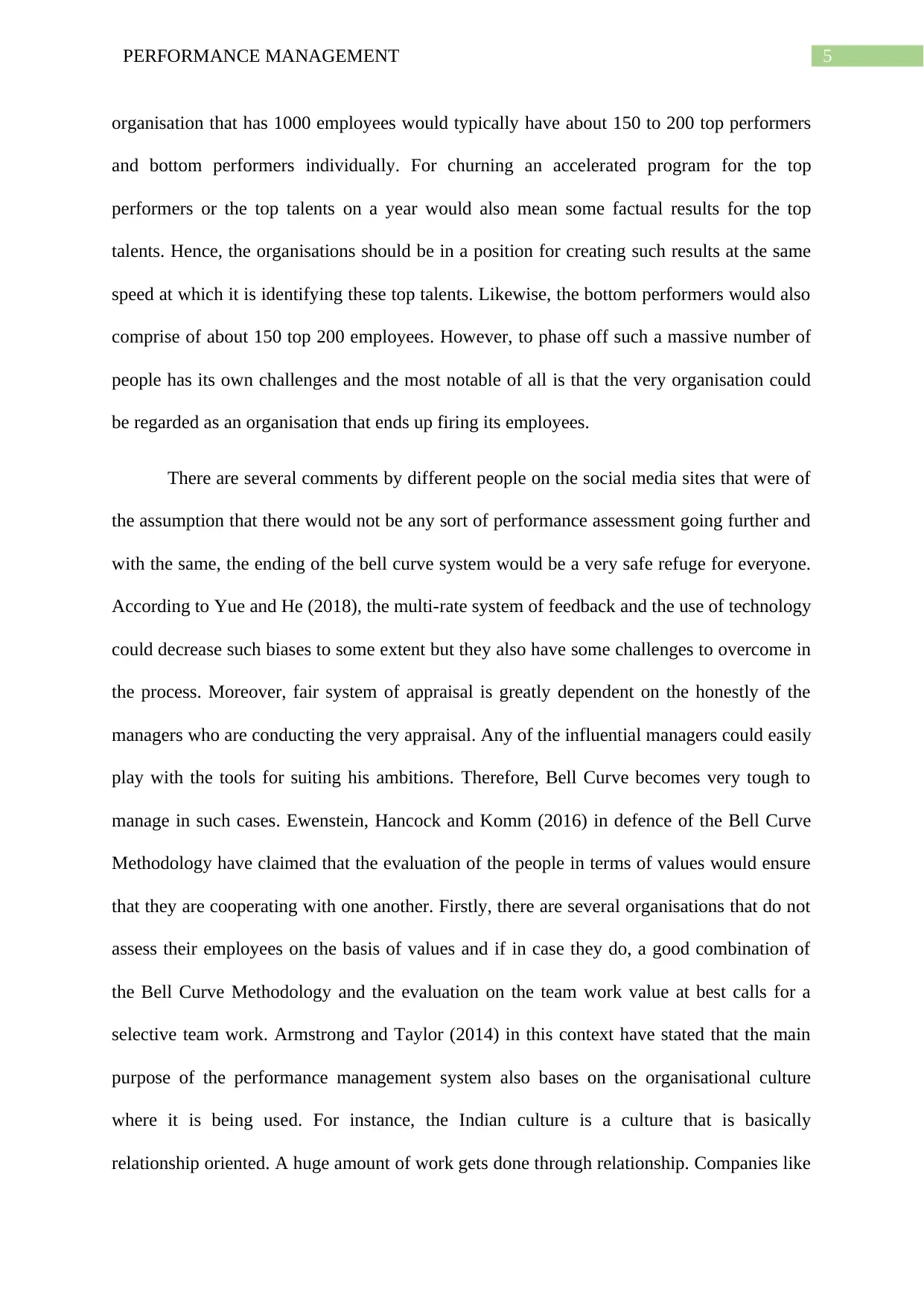
5PERFORMANCE MANAGEMENT
organisation that has 1000 employees would typically have about 150 to 200 top performers
and bottom performers individually. For churning an accelerated program for the top
performers or the top talents on a year would also mean some factual results for the top
talents. Hence, the organisations should be in a position for creating such results at the same
speed at which it is identifying these top talents. Likewise, the bottom performers would also
comprise of about 150 top 200 employees. However, to phase off such a massive number of
people has its own challenges and the most notable of all is that the very organisation could
be regarded as an organisation that ends up firing its employees.
There are several comments by different people on the social media sites that were of
the assumption that there would not be any sort of performance assessment going further and
with the same, the ending of the bell curve system would be a very safe refuge for everyone.
According to Yue and He (2018), the multi-rate system of feedback and the use of technology
could decrease such biases to some extent but they also have some challenges to overcome in
the process. Moreover, fair system of appraisal is greatly dependent on the honestly of the
managers who are conducting the very appraisal. Any of the influential managers could easily
play with the tools for suiting his ambitions. Therefore, Bell Curve becomes very tough to
manage in such cases. Ewenstein, Hancock and Komm (2016) in defence of the Bell Curve
Methodology have claimed that the evaluation of the people in terms of values would ensure
that they are cooperating with one another. Firstly, there are several organisations that do not
assess their employees on the basis of values and if in case they do, a good combination of
the Bell Curve Methodology and the evaluation on the team work value at best calls for a
selective team work. Armstrong and Taylor (2014) in this context have stated that the main
purpose of the performance management system also bases on the organisational culture
where it is being used. For instance, the Indian culture is a culture that is basically
relationship oriented. A huge amount of work gets done through relationship. Companies like
organisation that has 1000 employees would typically have about 150 to 200 top performers
and bottom performers individually. For churning an accelerated program for the top
performers or the top talents on a year would also mean some factual results for the top
talents. Hence, the organisations should be in a position for creating such results at the same
speed at which it is identifying these top talents. Likewise, the bottom performers would also
comprise of about 150 top 200 employees. However, to phase off such a massive number of
people has its own challenges and the most notable of all is that the very organisation could
be regarded as an organisation that ends up firing its employees.
There are several comments by different people on the social media sites that were of
the assumption that there would not be any sort of performance assessment going further and
with the same, the ending of the bell curve system would be a very safe refuge for everyone.
According to Yue and He (2018), the multi-rate system of feedback and the use of technology
could decrease such biases to some extent but they also have some challenges to overcome in
the process. Moreover, fair system of appraisal is greatly dependent on the honestly of the
managers who are conducting the very appraisal. Any of the influential managers could easily
play with the tools for suiting his ambitions. Therefore, Bell Curve becomes very tough to
manage in such cases. Ewenstein, Hancock and Komm (2016) in defence of the Bell Curve
Methodology have claimed that the evaluation of the people in terms of values would ensure
that they are cooperating with one another. Firstly, there are several organisations that do not
assess their employees on the basis of values and if in case they do, a good combination of
the Bell Curve Methodology and the evaluation on the team work value at best calls for a
selective team work. Armstrong and Taylor (2014) in this context have stated that the main
purpose of the performance management system also bases on the organisational culture
where it is being used. For instance, the Indian culture is a culture that is basically
relationship oriented. A huge amount of work gets done through relationship. Companies like
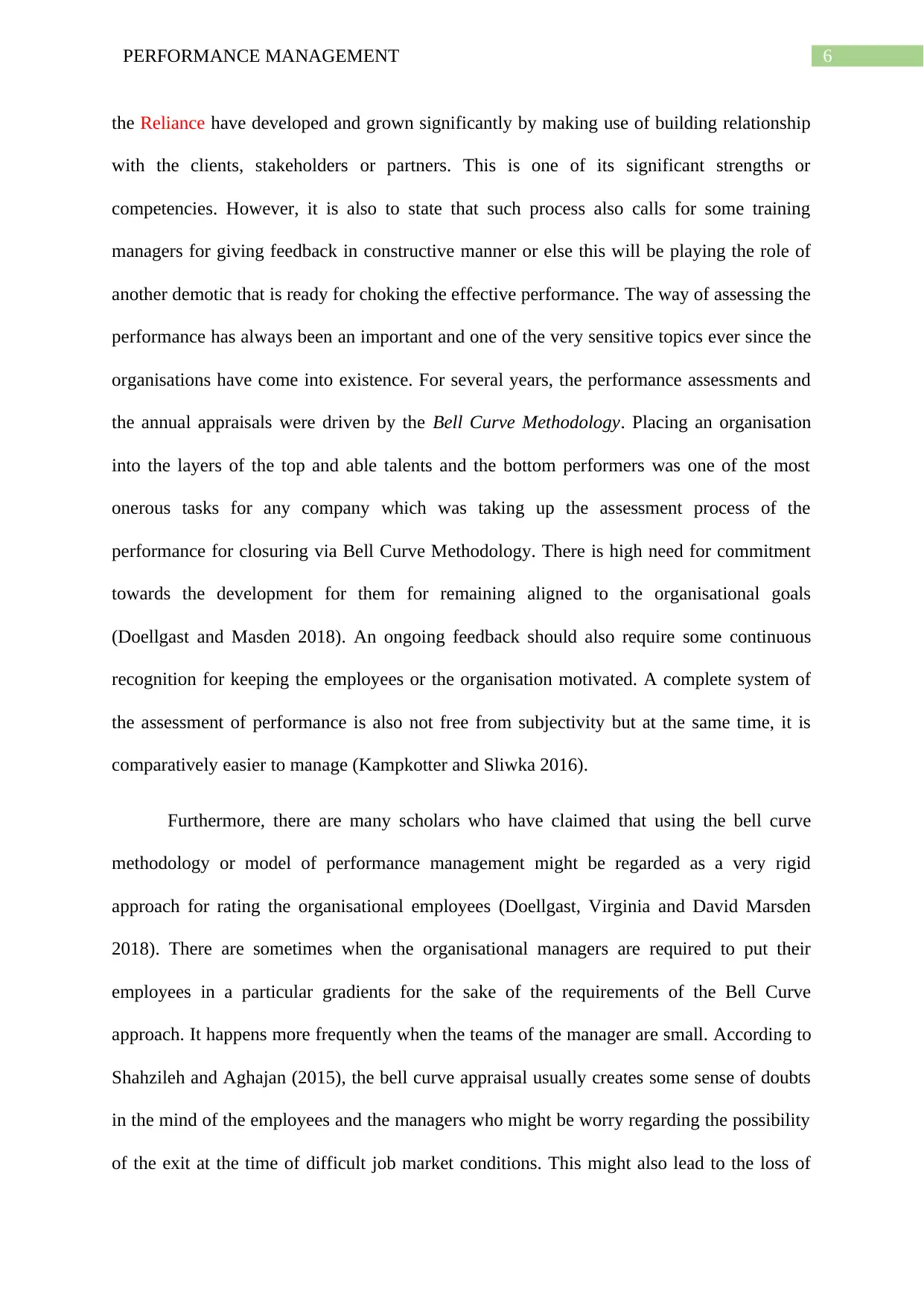
6PERFORMANCE MANAGEMENT
the Reliance have developed and grown significantly by making use of building relationship
with the clients, stakeholders or partners. This is one of its significant strengths or
competencies. However, it is also to state that such process also calls for some training
managers for giving feedback in constructive manner or else this will be playing the role of
another demotic that is ready for choking the effective performance. The way of assessing the
performance has always been an important and one of the very sensitive topics ever since the
organisations have come into existence. For several years, the performance assessments and
the annual appraisals were driven by the Bell Curve Methodology. Placing an organisation
into the layers of the top and able talents and the bottom performers was one of the most
onerous tasks for any company which was taking up the assessment process of the
performance for closuring via Bell Curve Methodology. There is high need for commitment
towards the development for them for remaining aligned to the organisational goals
(Doellgast and Masden 2018). An ongoing feedback should also require some continuous
recognition for keeping the employees or the organisation motivated. A complete system of
the assessment of performance is also not free from subjectivity but at the same time, it is
comparatively easier to manage (Kampkotter and Sliwka 2016).
Furthermore, there are many scholars who have claimed that using the bell curve
methodology or model of performance management might be regarded as a very rigid
approach for rating the organisational employees (Doellgast, Virginia and David Marsden
2018). There are sometimes when the organisational managers are required to put their
employees in a particular gradients for the sake of the requirements of the Bell Curve
approach. It happens more frequently when the teams of the manager are small. According to
Shahzileh and Aghajan (2015), the bell curve appraisal usually creates some sense of doubts
in the mind of the employees and the managers who might be worry regarding the possibility
of the exit at the time of difficult job market conditions. This might also lead to the loss of
the Reliance have developed and grown significantly by making use of building relationship
with the clients, stakeholders or partners. This is one of its significant strengths or
competencies. However, it is also to state that such process also calls for some training
managers for giving feedback in constructive manner or else this will be playing the role of
another demotic that is ready for choking the effective performance. The way of assessing the
performance has always been an important and one of the very sensitive topics ever since the
organisations have come into existence. For several years, the performance assessments and
the annual appraisals were driven by the Bell Curve Methodology. Placing an organisation
into the layers of the top and able talents and the bottom performers was one of the most
onerous tasks for any company which was taking up the assessment process of the
performance for closuring via Bell Curve Methodology. There is high need for commitment
towards the development for them for remaining aligned to the organisational goals
(Doellgast and Masden 2018). An ongoing feedback should also require some continuous
recognition for keeping the employees or the organisation motivated. A complete system of
the assessment of performance is also not free from subjectivity but at the same time, it is
comparatively easier to manage (Kampkotter and Sliwka 2016).
Furthermore, there are many scholars who have claimed that using the bell curve
methodology or model of performance management might be regarded as a very rigid
approach for rating the organisational employees (Doellgast, Virginia and David Marsden
2018). There are sometimes when the organisational managers are required to put their
employees in a particular gradients for the sake of the requirements of the Bell Curve
approach. It happens more frequently when the teams of the manager are small. According to
Shahzileh and Aghajan (2015), the bell curve appraisal usually creates some sense of doubts
in the mind of the employees and the managers who might be worry regarding the possibility
of the exit at the time of difficult job market conditions. This might also lead to the loss of
Paraphrase This Document
Need a fresh take? Get an instant paraphrase of this document with our AI Paraphraser
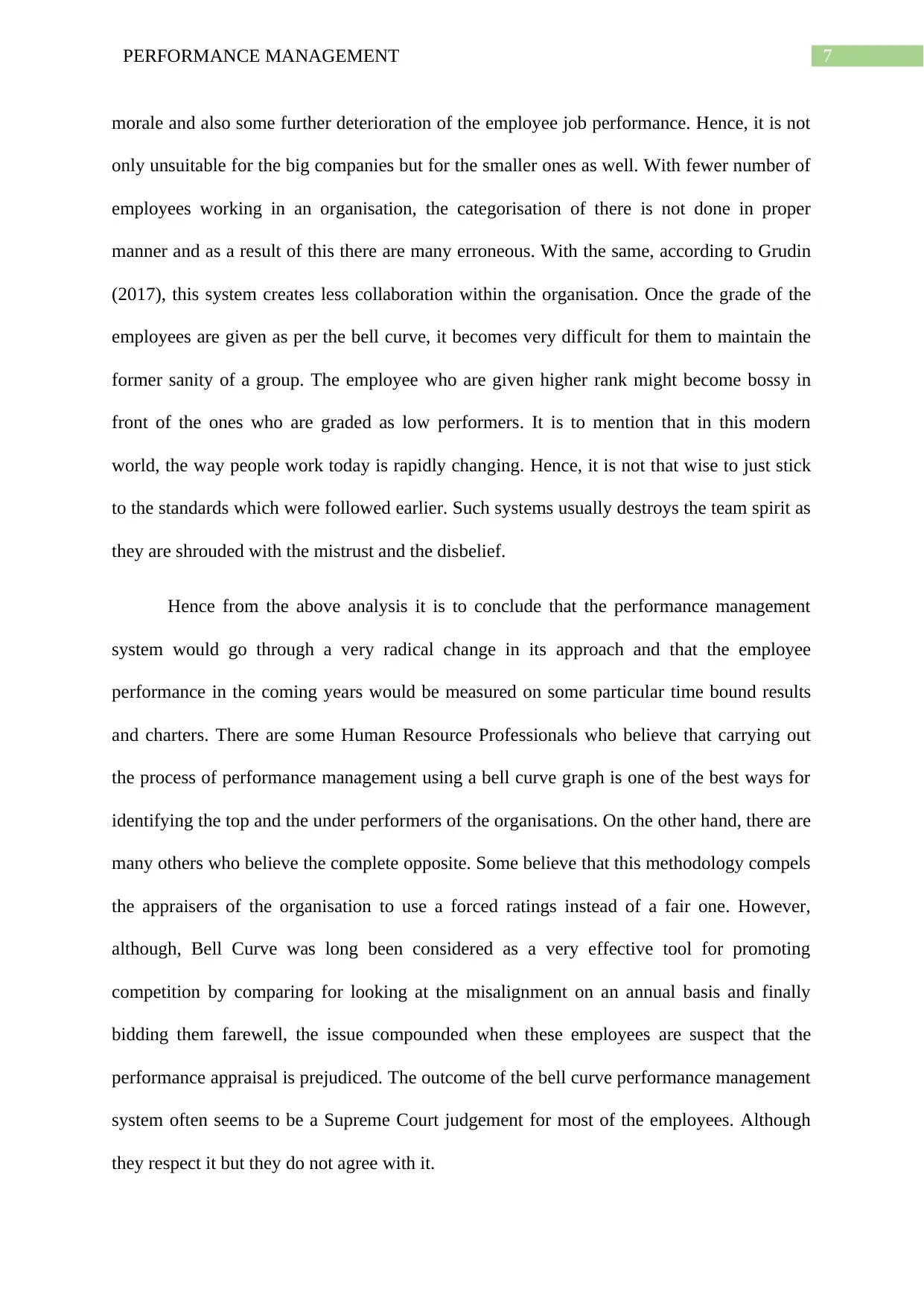
7PERFORMANCE MANAGEMENT
morale and also some further deterioration of the employee job performance. Hence, it is not
only unsuitable for the big companies but for the smaller ones as well. With fewer number of
employees working in an organisation, the categorisation of there is not done in proper
manner and as a result of this there are many erroneous. With the same, according to Grudin
(2017), this system creates less collaboration within the organisation. Once the grade of the
employees are given as per the bell curve, it becomes very difficult for them to maintain the
former sanity of a group. The employee who are given higher rank might become bossy in
front of the ones who are graded as low performers. It is to mention that in this modern
world, the way people work today is rapidly changing. Hence, it is not that wise to just stick
to the standards which were followed earlier. Such systems usually destroys the team spirit as
they are shrouded with the mistrust and the disbelief.
Hence from the above analysis it is to conclude that the performance management
system would go through a very radical change in its approach and that the employee
performance in the coming years would be measured on some particular time bound results
and charters. There are some Human Resource Professionals who believe that carrying out
the process of performance management using a bell curve graph is one of the best ways for
identifying the top and the under performers of the organisations. On the other hand, there are
many others who believe the complete opposite. Some believe that this methodology compels
the appraisers of the organisation to use a forced ratings instead of a fair one. However,
although, Bell Curve was long been considered as a very effective tool for promoting
competition by comparing for looking at the misalignment on an annual basis and finally
bidding them farewell, the issue compounded when these employees are suspect that the
performance appraisal is prejudiced. The outcome of the bell curve performance management
system often seems to be a Supreme Court judgement for most of the employees. Although
they respect it but they do not agree with it.
morale and also some further deterioration of the employee job performance. Hence, it is not
only unsuitable for the big companies but for the smaller ones as well. With fewer number of
employees working in an organisation, the categorisation of there is not done in proper
manner and as a result of this there are many erroneous. With the same, according to Grudin
(2017), this system creates less collaboration within the organisation. Once the grade of the
employees are given as per the bell curve, it becomes very difficult for them to maintain the
former sanity of a group. The employee who are given higher rank might become bossy in
front of the ones who are graded as low performers. It is to mention that in this modern
world, the way people work today is rapidly changing. Hence, it is not that wise to just stick
to the standards which were followed earlier. Such systems usually destroys the team spirit as
they are shrouded with the mistrust and the disbelief.
Hence from the above analysis it is to conclude that the performance management
system would go through a very radical change in its approach and that the employee
performance in the coming years would be measured on some particular time bound results
and charters. There are some Human Resource Professionals who believe that carrying out
the process of performance management using a bell curve graph is one of the best ways for
identifying the top and the under performers of the organisations. On the other hand, there are
many others who believe the complete opposite. Some believe that this methodology compels
the appraisers of the organisation to use a forced ratings instead of a fair one. However,
although, Bell Curve was long been considered as a very effective tool for promoting
competition by comparing for looking at the misalignment on an annual basis and finally
bidding them farewell, the issue compounded when these employees are suspect that the
performance appraisal is prejudiced. The outcome of the bell curve performance management
system often seems to be a Supreme Court judgement for most of the employees. Although
they respect it but they do not agree with it.
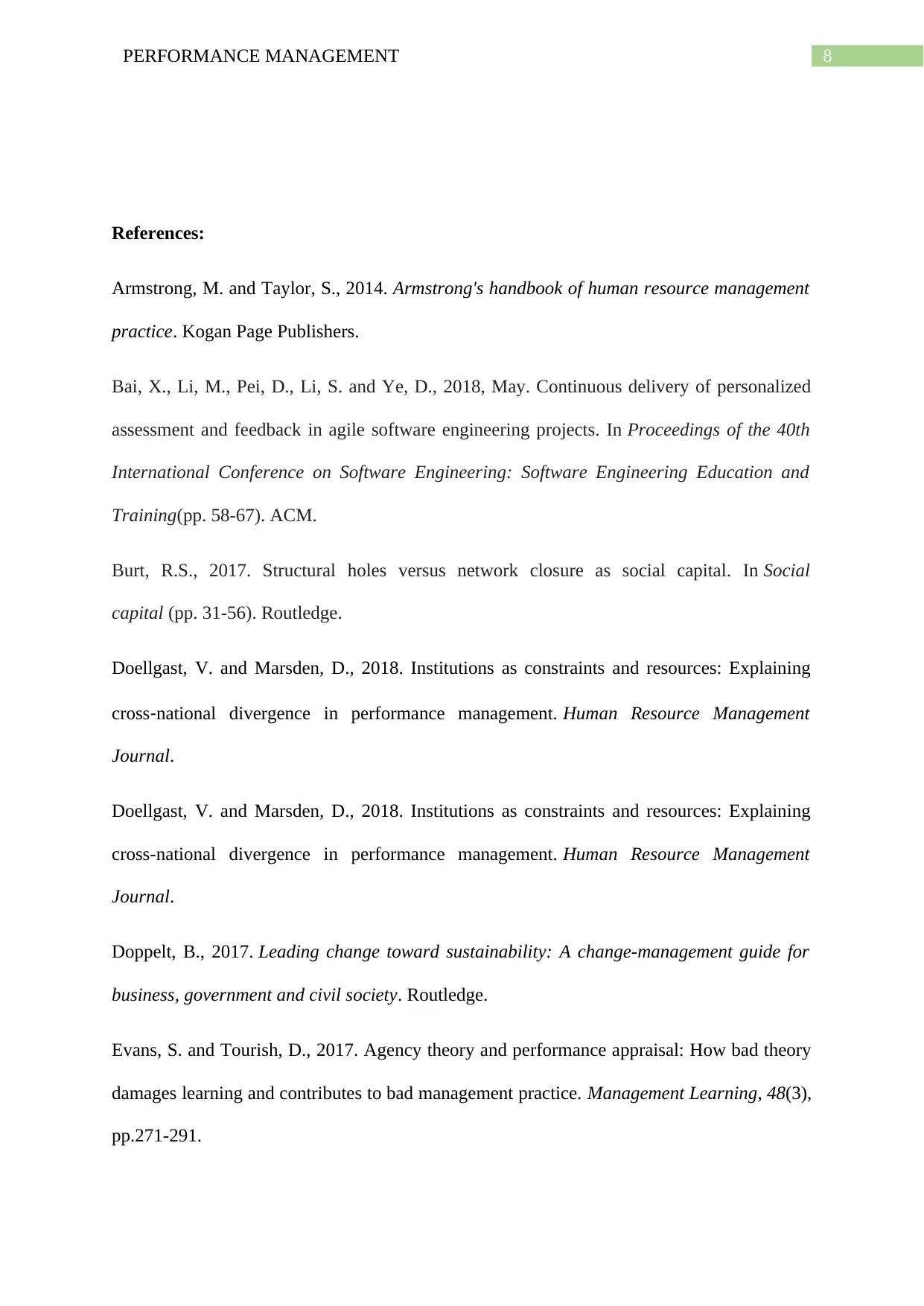
8PERFORMANCE MANAGEMENT
References:
Armstrong, M. and Taylor, S., 2014. Armstrong's handbook of human resource management
practice. Kogan Page Publishers.
Bai, X., Li, M., Pei, D., Li, S. and Ye, D., 2018, May. Continuous delivery of personalized
assessment and feedback in agile software engineering projects. In Proceedings of the 40th
International Conference on Software Engineering: Software Engineering Education and
Training(pp. 58-67). ACM.
Burt, R.S., 2017. Structural holes versus network closure as social capital. In Social
capital (pp. 31-56). Routledge.
Doellgast, V. and Marsden, D., 2018. Institutions as constraints and resources: Explaining
cross‐national divergence in performance management. Human Resource Management
Journal.
Doellgast, V. and Marsden, D., 2018. Institutions as constraints and resources: Explaining
cross‐national divergence in performance management. Human Resource Management
Journal.
Doppelt, B., 2017. Leading change toward sustainability: A change-management guide for
business, government and civil society. Routledge.
Evans, S. and Tourish, D., 2017. Agency theory and performance appraisal: How bad theory
damages learning and contributes to bad management practice. Management Learning, 48(3),
pp.271-291.
References:
Armstrong, M. and Taylor, S., 2014. Armstrong's handbook of human resource management
practice. Kogan Page Publishers.
Bai, X., Li, M., Pei, D., Li, S. and Ye, D., 2018, May. Continuous delivery of personalized
assessment and feedback in agile software engineering projects. In Proceedings of the 40th
International Conference on Software Engineering: Software Engineering Education and
Training(pp. 58-67). ACM.
Burt, R.S., 2017. Structural holes versus network closure as social capital. In Social
capital (pp. 31-56). Routledge.
Doellgast, V. and Marsden, D., 2018. Institutions as constraints and resources: Explaining
cross‐national divergence in performance management. Human Resource Management
Journal.
Doellgast, V. and Marsden, D., 2018. Institutions as constraints and resources: Explaining
cross‐national divergence in performance management. Human Resource Management
Journal.
Doppelt, B., 2017. Leading change toward sustainability: A change-management guide for
business, government and civil society. Routledge.
Evans, S. and Tourish, D., 2017. Agency theory and performance appraisal: How bad theory
damages learning and contributes to bad management practice. Management Learning, 48(3),
pp.271-291.
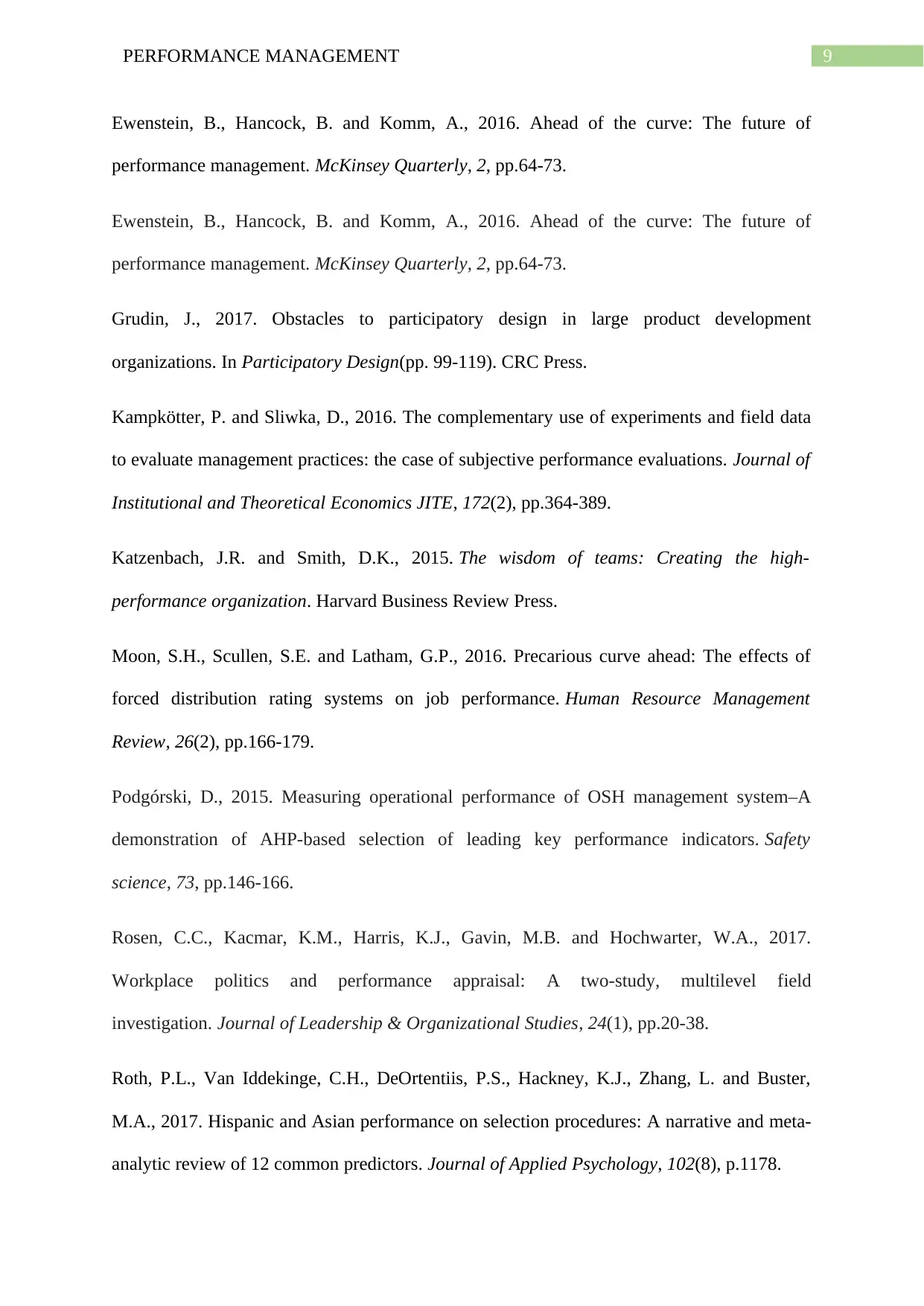
9PERFORMANCE MANAGEMENT
Ewenstein, B., Hancock, B. and Komm, A., 2016. Ahead of the curve: The future of
performance management. McKinsey Quarterly, 2, pp.64-73.
Ewenstein, B., Hancock, B. and Komm, A., 2016. Ahead of the curve: The future of
performance management. McKinsey Quarterly, 2, pp.64-73.
Grudin, J., 2017. Obstacles to participatory design in large product development
organizations. In Participatory Design(pp. 99-119). CRC Press.
Kampkötter, P. and Sliwka, D., 2016. The complementary use of experiments and field data
to evaluate management practices: the case of subjective performance evaluations. Journal of
Institutional and Theoretical Economics JITE, 172(2), pp.364-389.
Katzenbach, J.R. and Smith, D.K., 2015. The wisdom of teams: Creating the high-
performance organization. Harvard Business Review Press.
Moon, S.H., Scullen, S.E. and Latham, G.P., 2016. Precarious curve ahead: The effects of
forced distribution rating systems on job performance. Human Resource Management
Review, 26(2), pp.166-179.
Podgórski, D., 2015. Measuring operational performance of OSH management system–A
demonstration of AHP-based selection of leading key performance indicators. Safety
science, 73, pp.146-166.
Rosen, C.C., Kacmar, K.M., Harris, K.J., Gavin, M.B. and Hochwarter, W.A., 2017.
Workplace politics and performance appraisal: A two-study, multilevel field
investigation. Journal of Leadership & Organizational Studies, 24(1), pp.20-38.
Roth, P.L., Van Iddekinge, C.H., DeOrtentiis, P.S., Hackney, K.J., Zhang, L. and Buster,
M.A., 2017. Hispanic and Asian performance on selection procedures: A narrative and meta-
analytic review of 12 common predictors. Journal of Applied Psychology, 102(8), p.1178.
Ewenstein, B., Hancock, B. and Komm, A., 2016. Ahead of the curve: The future of
performance management. McKinsey Quarterly, 2, pp.64-73.
Ewenstein, B., Hancock, B. and Komm, A., 2016. Ahead of the curve: The future of
performance management. McKinsey Quarterly, 2, pp.64-73.
Grudin, J., 2017. Obstacles to participatory design in large product development
organizations. In Participatory Design(pp. 99-119). CRC Press.
Kampkötter, P. and Sliwka, D., 2016. The complementary use of experiments and field data
to evaluate management practices: the case of subjective performance evaluations. Journal of
Institutional and Theoretical Economics JITE, 172(2), pp.364-389.
Katzenbach, J.R. and Smith, D.K., 2015. The wisdom of teams: Creating the high-
performance organization. Harvard Business Review Press.
Moon, S.H., Scullen, S.E. and Latham, G.P., 2016. Precarious curve ahead: The effects of
forced distribution rating systems on job performance. Human Resource Management
Review, 26(2), pp.166-179.
Podgórski, D., 2015. Measuring operational performance of OSH management system–A
demonstration of AHP-based selection of leading key performance indicators. Safety
science, 73, pp.146-166.
Rosen, C.C., Kacmar, K.M., Harris, K.J., Gavin, M.B. and Hochwarter, W.A., 2017.
Workplace politics and performance appraisal: A two-study, multilevel field
investigation. Journal of Leadership & Organizational Studies, 24(1), pp.20-38.
Roth, P.L., Van Iddekinge, C.H., DeOrtentiis, P.S., Hackney, K.J., Zhang, L. and Buster,
M.A., 2017. Hispanic and Asian performance on selection procedures: A narrative and meta-
analytic review of 12 common predictors. Journal of Applied Psychology, 102(8), p.1178.
Secure Best Marks with AI Grader
Need help grading? Try our AI Grader for instant feedback on your assignments.
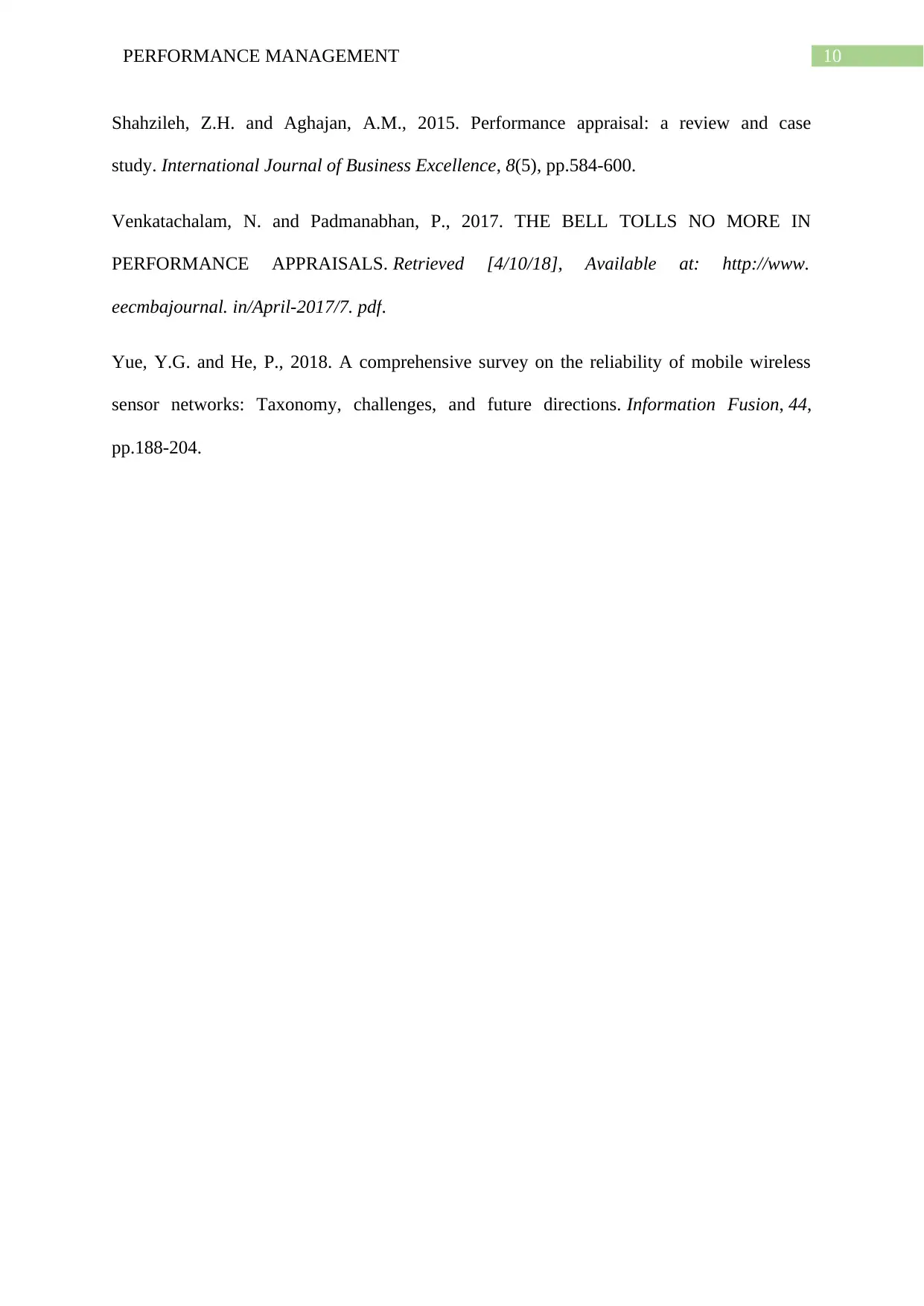
10PERFORMANCE MANAGEMENT
Shahzileh, Z.H. and Aghajan, A.M., 2015. Performance appraisal: a review and case
study. International Journal of Business Excellence, 8(5), pp.584-600.
Venkatachalam, N. and Padmanabhan, P., 2017. THE BELL TOLLS NO MORE IN
PERFORMANCE APPRAISALS. Retrieved [4/10/18], Available at: http://www.
eecmbajournal. in/April-2017/7. pdf.
Yue, Y.G. and He, P., 2018. A comprehensive survey on the reliability of mobile wireless
sensor networks: Taxonomy, challenges, and future directions. Information Fusion, 44,
pp.188-204.
Shahzileh, Z.H. and Aghajan, A.M., 2015. Performance appraisal: a review and case
study. International Journal of Business Excellence, 8(5), pp.584-600.
Venkatachalam, N. and Padmanabhan, P., 2017. THE BELL TOLLS NO MORE IN
PERFORMANCE APPRAISALS. Retrieved [4/10/18], Available at: http://www.
eecmbajournal. in/April-2017/7. pdf.
Yue, Y.G. and He, P., 2018. A comprehensive survey on the reliability of mobile wireless
sensor networks: Taxonomy, challenges, and future directions. Information Fusion, 44,
pp.188-204.
1 out of 11
Related Documents
Your All-in-One AI-Powered Toolkit for Academic Success.
+13062052269
info@desklib.com
Available 24*7 on WhatsApp / Email
![[object Object]](/_next/static/media/star-bottom.7253800d.svg)
Unlock your academic potential
© 2024 | Zucol Services PVT LTD | All rights reserved.





